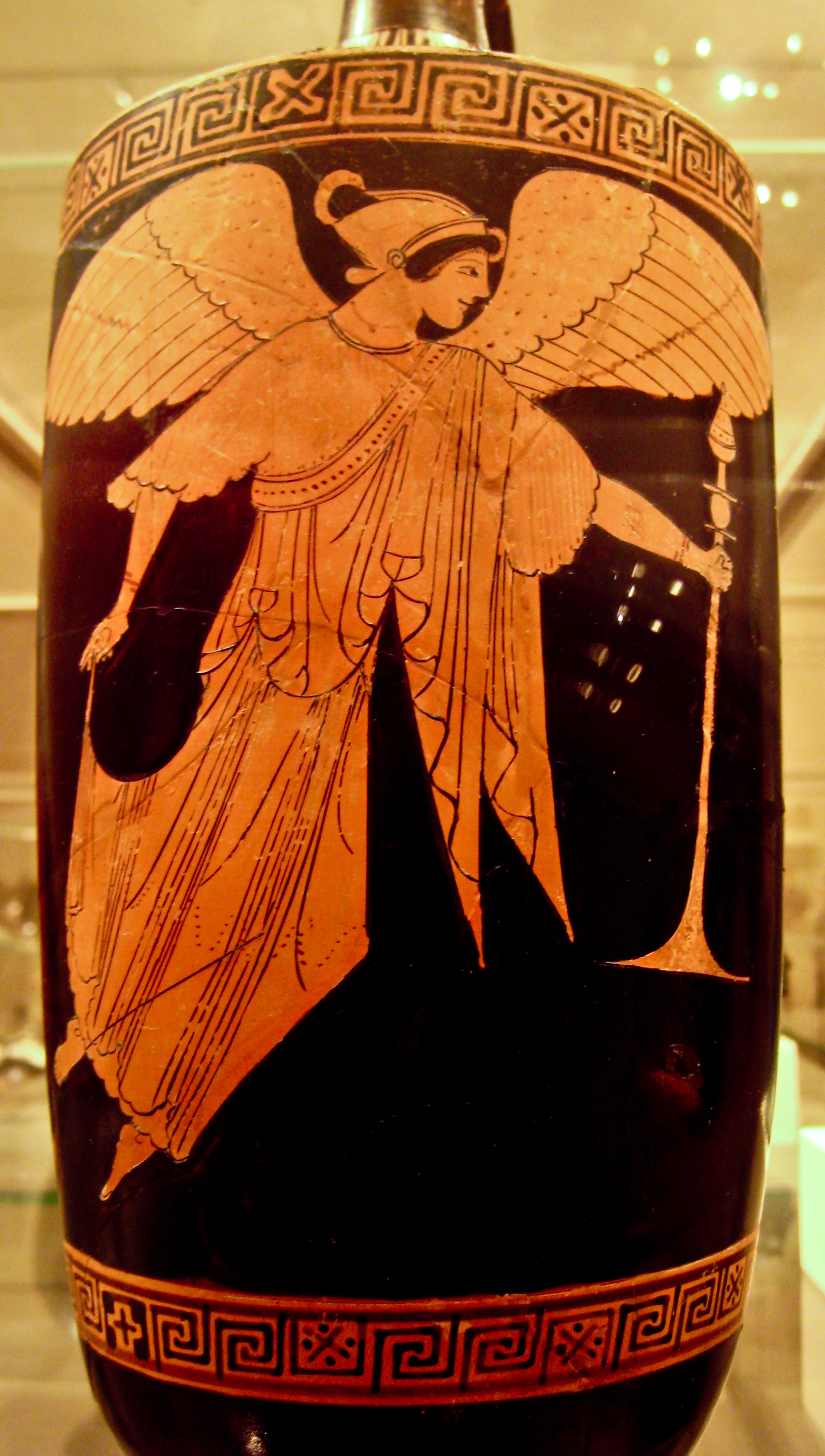 |
| Lekythos with Winged Victory with Incense Holder at Metropolitan Art Museum. 2009 © Sharon Mollerus. |
I had the pleasure to read through the Rangar Cline’s book entitled
Ancient Angels: Conceptualizing Angeloi
in the Roman Empire (2011) which discusses in great detail the concept of angelos (angel) in non-Abrahamic
religions (namely Judaism, Christianity and Islam) in the Roman era. It is an
incredibly interesting theme of scholarly debate from the early 20th
century. It is also a contemporary issue of discussion and debate for modern
Hellenic polytheists: what was the nature of angels in ancient Greek religion,
how it was involved and presented in the Late Greco-Roman religion, and how it
could be differentiated from its Christian understanding? Cline gives immensely
beautiful answers with the use of literary, inscriptional, and archaeological
evidences. Cline focuses to the study of the Greco-Roman understanding of
angels and how they have been worshiped. For Cline, the Christian authorities reacted
to this unorthodox characteristic of Roman religion. The author does not “attempt
to trace religious influence in one direction or another” (p.xvii), and seek to
bring a holistic view of the popular beliefs about angels in Greco-Roman
religion, equally providing the prevalent assumptions about and veneration of
them in the Late Antiquity, Roman Empire.
It is quite straightforward from the archaeological and literary
evidences that angelos (the Greek
term for ‘angels’) was a noteworthy feature of the Late Antiquity’s Greco-Roman
religion (p.2). An interesting first attempt for
scholarly evaluate the non-Christian conception of angles in the ancient World
was in Cumon, F., (1915) “Les anges du paganisme,” Revue de l’histoire des religions, 12, pp. 159–182 and later in Sheppard,
A. R. R., (1980/1981), “The Pagan Cult of Angels in Roman Asia Minor,” Talanta, 13-14, pp. 77–101. The term appears in Homer (a messenger, envoy, Il.24.292,296.) later in Herodotus (Hdt.5.92); all ancient Greek literary
sources identifying angelos as a term which defines a specific responsibility or assignment
that labelled the function of a particular deity or a ‘semi-divine’ (celestial)
being. For Gentiles as well as for the first Christians throughout the
antiquity, angelos means a messenger
of divine communication (generally, one that announces, of birds of augury, Il.2.26.; Μουσῶν ἄγγελος, of a poet, Theogn.769; Διὸς ἄγγ., of the nightingale, Soph. El. 149.; c. gen. rei, ἄγγ. κακῶν ἐμῶν id=Soph. ; in LSJ, ἄγγελος , ὁ, ἡ).
Though angelos in its
origin does not ineludibly represent a ‘semi-divine’ (celestial) being, it will
eventually be used to identify a special class of ‘semi-divine’ (celestial)
beings. Angelos, would be eventually,
especially in the second and third century AD, described as a “semi-divine
being or a lesser god in the service of a supreme god, a manifestation of a
supreme god, the soul after death, or even a guardian spirit” (p.3).
For that specific reason the Christian Apologetics tried to outline
a distinction between the Christian and non-Christian use of the term. In the
Origen versus Celsus debate, it is evident that the focus on the division of
meaning was based on the sematic relation between the terms angelos, daimon and theos. Origen identified
the theological problem founded in the scriptures, which is the use of the term
angelos as a reference to theoi (the gods). Immediately, in this
point the rhetorical fallacy can be clearly viewed: as the Gentile theoi where daemons (evil spirits), also mentioned in the scriptures as angeloi, thus angelos could be a malevolent spirit too. Resulting to confusion in
the early Christian writings, Origen stated that Christians should not venerate
angels but straightforwardly pray and worship God (Contra Celsum, 5.4). In similar lines of argumentation Augustine
suggested that the term daimon can be
used only for malevolent spirits and angelos
could be both be God’s “boni angeli” as well as an evil spirit. He further argued
that the Neo-Platonic philosophers (namely Porphyry; see Civ. Dei., 10.26) theosophical rituals and their worship of angeloi were actually venerating daimones, evil spirits, or angels of Devil
(Civ. Dei., 9.19). The Augustine’s
argumentation is a good example to an alternative reading of the already existent
terminology for the divine.
In fact there was a term used for the ‘evil angel’ – or in a
similar approach – in the Hellenic Polytheistic World, which according to LSJ is ἀλάστωρ, (ορος, ὁ, ἡ) is an avenging
spirit or deity, with or without δαίμων, (freq. Trag., A.Pers.354, Ag.1501, 1508, cf. Men.8); “ἀ. οὑμός” (S.OC
788); “ἐξ ἀλαστόρων νοσεῖν” (Id.Tr.1235);
“ἀλάστορας ἔχειν” (Hp.Morb.Sacr. 1); “Ζεὺς
Ἀ.” (Orph.H.73). he who does deeds
which merit vengeance, wretch, (A.Eu.236,
S.Aj.374); μιαροὶ..καὶ “κόλακες καὶ ἀ.”
(D.18.296); “βάρβαρόν τε . . καὶ ἀ. τὸν
Φίλιππον ἀποκαλῶν” (Id.19.305); “ἄνθρωπ᾽
ἀλάστωρ” (Bato 2.5, cf. Men.7D., Pk.408); “Διονύσιος ἁπάσης Σικελίας ἀ.” (Clearch.10). It was, therefore, a fact that different polytheistic cults
of the Greco-Roman World used the term angelos
to pray and venerate the divine which according to Cline “reveals the role of Hellenism
in allowing distinct and divergent religious traditions to express similar
ideas about angeloi in a common
religious vocabulary” (p.167).
Ancient Angels: Conceptualizing
Angeloi in the Roman Empire (2011) is an excellent source for readers and
scholars interested on the concept of angels within the Greco-Roman
polytheistic religion.